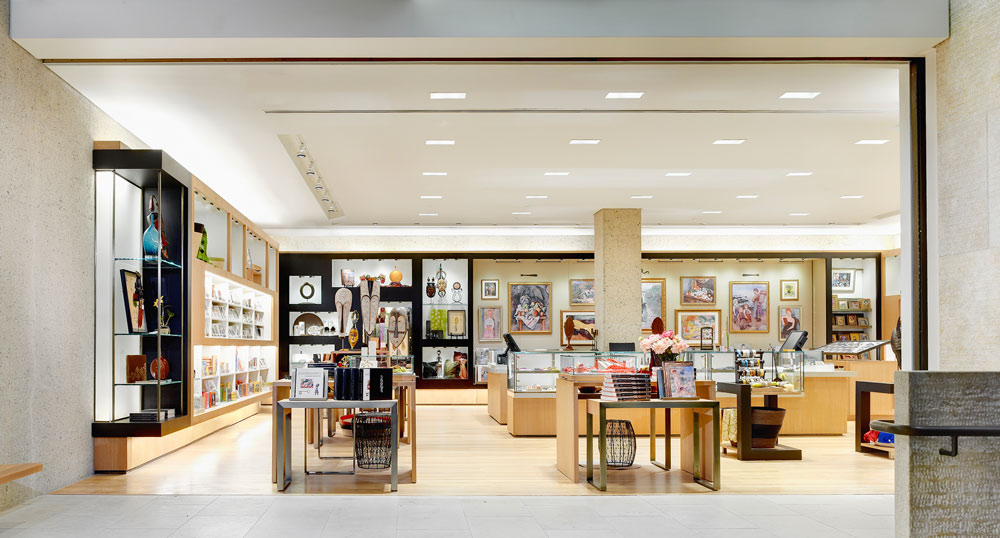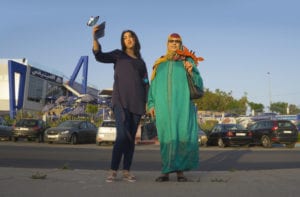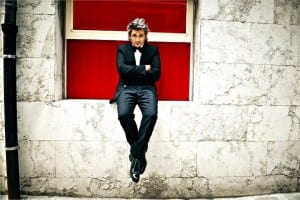We’ve all visited a museum and been forced to exit through the gift shop. The assumption is often that visitors will not give the shop a second look unless they literally have to walk through it to leave the museum. Meet Franci Sagar, a woman who’s made a career out of turning this assumption on its head. Not only is Sagar the Vice President and Director of Retail and Brand Development at Museum of Arts and Design in New York City—she’s also the founder of Lakeside Collaborative, a group that provides its unique consulting services to specialty retailers, non-profit museums and other cultural institutions. We had a chance to chat with Franci about how she developed her eye for creative retail and the ways she’s giving museum stores major makeovers for this month’s “Jobs in the Art World.”
AZ: What is something that you wish you knew at the beginning of your career?
FS: What we don’t know at the beginning of our journey is often what allows us to make all the crazy decisions and to take all the risks. If anything, I sometimes wish I knew less now—some of the best decisions I’ve ever made were before I knew how difficult they would be to execute. But if I had to pick, I wish I would have known that it was okay to wear comfortable shoes.
AZ: Besides being the VP of Retail and Brand Development at MAD (The Museum of Arts and Design), you also have your own consulting firm, Lakeside Collaborative, with clients such as the Barnes Foundation, the Perez Art Museum Miami, the Rubin Museum, and most recently Lincoln Center. How do you manage your time and what does a typical day look like for you?
FS: My day starts with looking at yesterday’s emails to make sure nothing has fallen through the cracks. My business partner (and daughter) arrives for an 8 am work session to review our current client projects and business development opportunities. This often includes a phone call with any one of our collaborators, sometimes an architect or graphic designer to discuss a client’s branded retail identity program or store design.
Then it’s the A train up to MAD. There, the first thing I do is check in with my retail staff on the day’s agenda. On any given day, I might follow that up by reviewing artist product submissions and meeting with other MAD leadership to strategize how retail can extend the museum’s departmental endeavors. We’re always seeking new ways for The Store to contribute to the visitor experience and promote messaging. There’s usually a long-range project on the calendar that needs addressing—a trunk show, an off-site MAD pop-up, or a marketing initiative. On days when I’m not in the museum, I’m visiting makers’ studios and showrooms or combing through a trade show on its behalf, and I often travel locally and globally to discover new talent beyond what the tradeshows present.
All of that is to earn my sacred time on the retail floor alongside my staff, eavesdropping on customer comments while I visually change up/merchandise the product on the floor. I move one thing and it ends up being a whole new choreography between products. My day ends by disconnecting electronically and taking some downtime.
AZ: How do you cultivate relationships with makers and artists?
FS: Earning the makers’ trust is hugely important—visiting their studios and listening to their stories is an integral part of becoming acquainted with their process. Trust develops through the conversation. It’s about keying into their passion, what moves them, how they do what they do and what they want other people to know about their work. Our role as museum retailers is to translate the intimacy of this dialogue to the customer. We’re a bridge between the artist, the customer and the museum. I like to think that our collaboration goes towards them being able to sustain a living doing what they love, from the sale of their work.
I think that’s why visual merchandising and retail environment design is so central to my role as a retail strategist. I want each artist I work with to feel their work is being placed with care and an aesthetic sensitivity. For instance, I make sure all our glass is displayed where it can capture light and that complementary materials are placed together in inspiring compositions that make people rethink the way they live with objects.
AZ: On your website you call what you do “mission-driven retail.” What is that and how did you come to it?
FS: “Mission-driven retail” describes retail as a language used to communicate a set of values and a platform for social impact. In the art world, this is the parent institution’s mission.
I came to MAD 16 years ago based on the reputation of my retail business, ZONA. ZONA was an iconic lifestyle store my then-husband and I built in Soho in the 80s when Soho was at the center of the art world, and the retail stores that were opening than were an extension of that artistic creativity. I became known for a signature merchandising style that focused on visual storytelling and product vignettes. It was different from the “gallery” trend: it was tactile and sensorial. It was a hop and skip away from what was missing in museum stores. I didn’t know in the days of ZONA that what I was doing would morph into what we like to call “mission-driven retail”—where each retail touchpoint is in service to a message.
After I had left ZONA, I was brought on to rethink the retail experience at MAD. I realized how instrumental retail could be as a brand asset and as a medium through which to communicate a museum’s mission. I saw each customer in the store as a museum patron, and the product assortment and retail experience offered had to be commensurate with the role of patron supporting the museum and the exhibitions. That’s fundamentally what shopping in museum stores is: an act of modern patronage.
At Lakeside we design immersive retail identities that echo and underline the parent brand’s mission. The stores we design become brand assets. It’s a place where a museum can be a bit lighter on its feet. With The Store at MAD, we base all of our decisions on how we can best mirror MAD’s sensibility and mission to showcase innovation in craft, art and design. Just as it does for its exhibitions and educational programs, The Store at MAD is about celebrating the creative process through which materials are crafted into works that enhance contemporary life. That’s mission-driven retail in action.
AZ: Any advice to those who want to be sold in a museum store?
FS: Target a museum that truly resonates with the message behind your work. Identify stores that align with your philosophy because in many ways, those stores will be the face of your product, and the staff will be telling your story. It’s also critical that you develop a consistent business acumen: study best-practices such as how to create wholesale invoices, meet deadlines and most of all, keep making and refining your body of work.

AZ: As the founder and director of Lakeside Collaborative, what are some of your favorite projects that you have worked on?
FS: Each project Lakeside decides to take on is so rich and unique in its own right. It’s one of the things I love about working in our niche.
I’d say participating in the move of the Barnes Foundation from its old campus in Merion, PA into its new Tod Williams + Billie Tsien building was an incredible opportunity and emotionally powerful experience. It raised a lot of important questions around how arts institutions will continue to innovate and evolve while preserving their curatorial vision.
Another favorite moment was last winter when The Store at MAD entered the world of fine jewelry. At the opening evening of “Redefining Fine Jewelry,” I was moved by the emotional reaction some of the jewelers had while seeing their work in our store. As people whose artistry is the handling of precious stones and metal under a microscope, we helped them zoom out and appreciate what they’ve made through the eye of the customer. Quite literally, we shined new light on their creations.
We actually had our spring launch on May 4th. We invited 16 jewelers who are exploring what it means to create the modern heirloom and whose approaches reflect the ethos of MAD’s mission to present work at the intersection of art, craft, and design.
AZ: What are a few key elements that you strive to incorporate into each initiative you design?
FS: My hope is that our clients’ stores uproot the antiquated concept of a “museum gift-shop.” I aim to make each mission-driven retail experience a call-to-action, and also to ensure that they exist in their own right as specialty retail destinations. We also work to present a highly unique assortment of products inspired by the parent institution that can act as vessels for the memories people take away from their visits.
Our approach to retail design is truly guided by the belief that we can transform the retail experience from a place of empty consumption into an act of conscious consumerism and a statement of affiliation with a higher purpose.
What I love about leading the retail at MAD is that MAD’s reason for being is the same as The Store at MAD, which is to bring this creativity into people’s everyday life.

AZ: How is designing retail experiences for arts institutions different than designing for purely commercial retailers?
FS: The relationship between commerce and art can be controversial in a museum setting. But the truth is, we are a sustainable stream of revenue that represents a body of patrons for both the makers and the museums their stores represent.
The gap between for-profit and non-profit is shrinking. Today’s consumer cares about where they buy and the story or cause behind it. I would say that for-profit retailers could learn something from museum retail and how to design a store experience powered by a mission. At the same time, arts institutions are learning how to stop marginalizing retail and how to leverage their stores as a point of access for visitors to participate in the museum’s goals.
In my opinion, the more elevated the retail platforms of arts and cultural institutions stores become, the better it is for all arts and cultural institutions. It raises the precedent and creates the desire in people to want to discover the museum store on their visit. Having one good experience at a museum store prepares them to seek out more good experiences at other museum stores. The more museums concentrate on elevating their retail standards, the better.
AZ: Who do you look up to in the art world?
FS: I admire the artists and makers who persevere to create a sustainable living from their passion and who put their work out there to make the world a better place.
And then there’s Michael Beirut at Pentagram. He’s in the art world for me. Tod Williams and Billie Tsien. They are in the art world. These are my heroes in the art world—those whose “art,” whose “craft” is called on to communicate the spirit and conserve the relevance of creativity and art in our daily lives.
AZ: Are you hiring?
FS: Lakeside draws on an open-source network of creatives to collaborate with on new projects and accomplish upcoming goals. People interested in working with us can contact us through our website. So yes, we’re always “hiring”—we’re always looking to add to our talent call-list.



